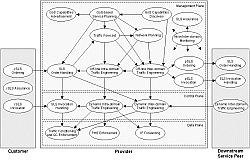 The
MESCAL functional architecture describes from the perspective of
a single provider the functions required for the provision of inter-domain
QoS services. The architecture decomposes the functions required
to provide inter-domain QoS: this enables the development of Inter-domain
QoS solutions by breaking the overall problem down into manageable
entities while maintaining a holistic view of the problem. The
MESCAL functional architecture describes from the perspective of
a single provider the functions required for the provision of inter-domain
QoS services. The architecture decomposes the functions required
to provide inter-domain QoS: this enables the development of Inter-domain
QoS solutions by breaking the overall problem down into manageable
entities while maintaining a holistic view of the problem.
The
main functional groups in the architecture are: Service Planning
and QoS Capabilities Exchange; Network Planning and Provisioning;
Off-line Traffic Engineering; Dynamic Traffic Engineering; SLS Management;
and Monitoring and SLA Assurance.
The
management plane includes off-line functionality, typically located
in management servers outside the network elements. Relevant functions
are responsible for (a) interacting with customers and service peers
to negotiate contracts and (b) implementing the business decisions
of the INP through planning, dimensioning and configuring the network.
The control plane covers intra- and inter-domain routing, handling
the admission of traffic flows, and dynamic resource management
including load distribution and capacity management functions. Typically,
control plane functions are embedded within network elements although
they are not involved in packet-by-packet decisions. Finally, the
data plane is responsible for per-packet treatment, and is configured
by the control plane.
The
management plane functions run at the epochs of the so-called resource
provisioning cycles (RPCs). In MESCAL we define two RPCs – the intra-domain
RPC, for off-line intra-domain Traffic Engineering, and the inter-domain
RPC for off-line inter-domain Traffic Engineering. At RPCs network
resources are optimized to meet predicted demand, including sufficient
spare capacity to avoid network reconfiguration at each SLS subscription
or renegotiation, while avoiding the inefficiencies of massively
over-provisioned resources.
The
architecture should be seen as a framework for control and management
plane functionality required for deploying and operating inter-domain
QoS-based services, although this is not prescriptive in the sense
that all functional blocks are mandatory in any particular implementation
of an INP. The architecture is independent of the particular algorithms
used to implement each functional block, or even of the network
technologies used to deploy traffic engineering. This functional
model is seen as one of the major exploitable results from MESCAL
as it has the potential to influence commercial implementations
of QoS-based services as well as standardisation activities.
Further
reading:
M.P.
Howarth, P. Flegkas, G. Pavlou, N. Wang, P. Trimintzios, D. Griffin,
J. Griem, M. Boucadair, P. Morand, H. Asgari and P. Georgatsos,
"Provisioning for Inter-domain quality of service: the MESCAL
approach," IEEE Communications Magazine, June 2005. [link]
MESCAL
deliverable D1.3, "Final specification of protocols and algorithms
for inter-domain SLS management and traffic engineering for QoS-based
IP service delivery", Chapter 6. [link]
|